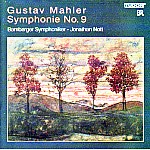There was a time when it was difficult to find a mediocre performance of this symphony, but no longer. Jonathan Nott’s interpretation has many personal touches, but they are all of the same type. Briefly, he emphasizes clarity of texture to the point where he loses sight not just of the long musical line, but also of the passionate intensity of Mahler’s tragic vision. There are basically two problems with pursuing transparency at all costs. The first, and most serious, concerns the fact that the kind of control that Nott requires means that all of his climaxes sound inhibited. “With the utmost power”, Mahler urges at the climax of the first movement, but this is nowhere near what Nott and his players achieve. They are at their best in the quiet moments between the loud bits, where the texture is less complicated–but then anyone can play the game of “bring out the subordinate part”.
Similarly, Nott’s subdued opening of the finale is very beautiful, its restraint emphasizing the passion simmering below the music’s surface. Unfortunately, that is where it stays, and so the contrast between the main theme and those “without expression” interludes fails to tell as it should, and the coda comes across as expressively bland. Nott’s handling of the second movement doesn’t come close to doing justice to the first dance’s rustic clumsiness (the waltz goes much better), and while the opening of the Rondo:Burleske is a marvel of contrapuntal clarity, Nott’s obsessive attention to vertical detail quickly lets the music degenerate into a mere mechanical exercise, choppy and unconvincing.
The second problem with Nott’s approach is that he’s only partially successful at his own game. Again, it’s the tuttis that spell his downfall. Where are the horns (with the “bell” motive) at the forte counterstatement of the first movement’s opening theme? Where is the trumpet at that theoretical “with the utmost power” climax? There are other misjudgments as well. Nott’s handling of transitions is particularly fallible. Check out the lame trumpet and timpani fanfares and stiff accelerando leading into the opening movement’s second “collapse” episode, or the awkward return to the Rondo after the calm central episode. And why does Nott accelerate so obviously and so soon before the point where Mahler actually asks him to?
Finally, there are the sonics. It may be that the diffuse engineering accounts to some extent for the lack of impact at the big moments, never mind the balances that favor the strings (not very flatteringly) at the expense of the high brass and woodwinds. But the fact remains that Nott’s interpretation signally fails to inspire the players to surpass themselves. So he must take responsibility for their comparative timidity. I have no doubt that they are better at what they do than he is, and could be more impressive if he would simply get out of the way and turn them loose where the music demands it. In short, this performance has all the hallmarks of being carefully rehearsed in many of its less important details, and neglected in the areas that truly matter.
































